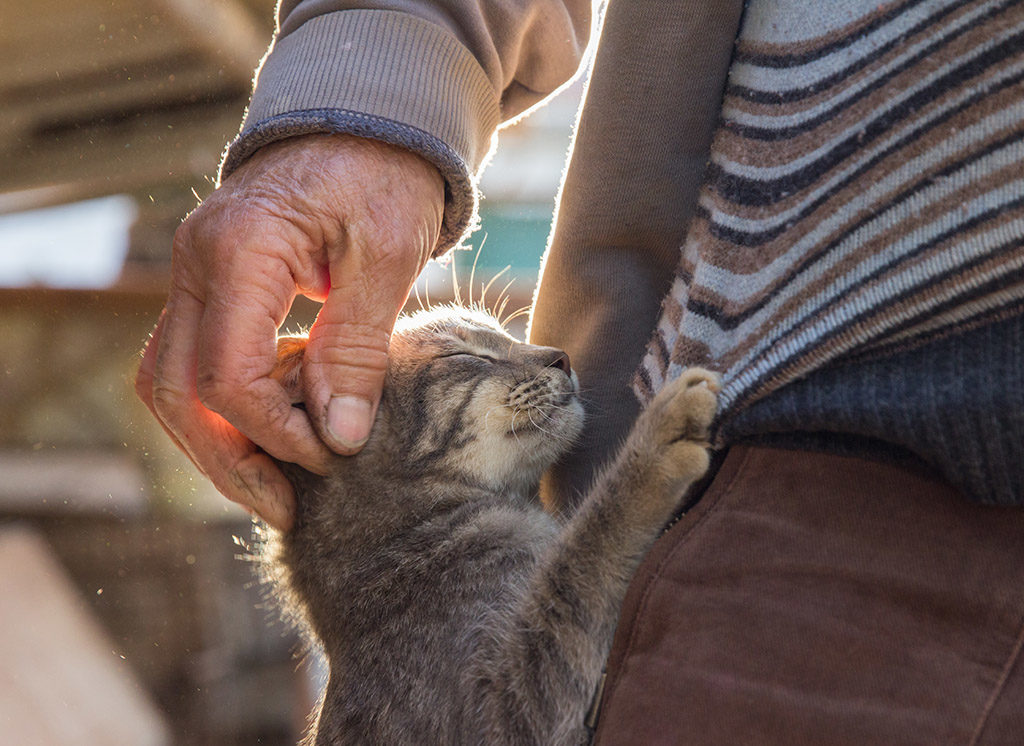Domestic cats are a wonderful species that have been living close to and with humans for thousands of years. They were revered in Ancient
Egypt… and still are in many homes where their faithful human servants attend to them. Jokes aside, cats are fascinating and are incredibly
well adapted to living with us. However, as humans, we often make the error of thinking of them as ‘small furry people’ or ‘little meowing
dogs’ – big mistake!
What makes cats different?
Cats interact in a different way from dogs and people. During the breeding season, feral cats will live together in groups of related adult females (mothers & daughters), where they can provide for and defend their kittens. Close physical contact is often seen between kittens and the adult females, however as they grow and become more mature, these interactions may become less frequent and change in expression. Adult male cats are usually at the periphery of the group with one tom usually breeding the majority of females in his territory and other males being rejected from the area. The focus is aimed at survival by protecting resources such as food, water, shelter etc. with outsiders or ‘strangers’ seen as competition for those resources. Members in the group will display hostile behaviours towards ‘strangers’ so as to protect their access to the resources. These hostile behaviours are designed to keep the ‘strangers’ far away i.e. urine marking, body language and vocalising.
Litter mates spend lots of time in close contact
However, if a ‘stranger’ has not heeded these warning signals and they come into close proximity, the physical interactions can be intensely aggressive. Within a stable social group however, physical conflict is rare and most communication is by body language which is designed to avoid the risk of injury.
As adults outside of the mating season, cats are generally solitary animals with self-preservation of utmost importance. They spend most of their time on their own, doing their own thing and without an instinctual need for social cooperative behaviours as occurs in other species like humans and dogs. As humans, we generally don’t survive so well on our own… This simple fact goes a long way to explaining why cats behave the way they do – they do not rely on social interactions for their survival; they’re ‘nice-to-haves’ rather than ‘must-haves’ for cats. It also means that they have fewer “making friends” behaviours than other socially obligate species, like dogs, do. In other words, cats can be quite happy spending a limited amount of time with a select few people or fur friends and generally do not feel the need to be in constant social contact with other creatures.
But what about my cat? I’m sure she enjoys cuddles.
Having discussed the general tendencies of most cats, there are definitely variations in the sociability between individuals. Some individuals have a very low requirement for social interactions – these may be kitties that spend a lot of time out in the garden, come in for a meal and then disappear again only to be seen at the next meal. Others have a higher requirement for social interactions and these individuals may be better suited to living in a domestic environment. There are also ways in which we can influence this tendency in more sociable cats by the way we raise kittens. It has been scientifically proven that appropriate handling of kittens between 3 and 7 weeks old, when they are in a positive emotional state, certainly makes them more amenable and comfortable with our human desire for close contact and cuddles. This means that socialised kittens are more likely to learn that human behaviours are not threatening and accept them as normal. Even so, these cats will still prefer low intensity high frequency interactions e.g. regularly walking passed an owner doing a little ‘meow’ is characteristic of a friendly feline social interaction. On the other hand, humans tend to have high intensity, low frequency interactions e.g. one long cuddle a day. This means that as cat owners, we need to be realistic about what we can expect from our interactions with our cats as well as the cat’s interactions with other people and animals in the household.
What does this mean for living in the “real world” with pet cats?
Because of cats’ solitary natures, they can be quite secretive about their eating, grooming and toiletting habits. For kitties there is no fun in going to the toilet in a group like a bunch of teenage kids. Nor do they want to ‘sit around the dinner table’ and share a meal. And cleaning themselves? That is most definitely a private affair! Here are a few guidelines that you can use at home to assist in setting up your space so that it is indeed kitty friendly:
How do you know when things are going wrong?
By understanding how cats interact with each other, us and other species, we are able to provide them with options where they can express their normal behaviours and have a high quality of life. Sometimes though, it can be difficult to understand what cats are trying to tell us (or somebody else!) This list (by no means exhaustive) offers some clues that you and your cat may need some help:
The causes for these changes may be medical, environmental, social or behavioural. Do not ignore these signs – they are like little bells that should alert you that there may be an issue. This is also the point where you should definitely discuss your concerns with your vet.
If you do have concerns about your cat’s behaviour or just need some advice about how to best set up for a happy cat, please give us a call on 0481 527 678 or email to book an appointment. We’re looking forward to meeting you both!


News & Updates
🐾 Now on the Sunshine Coast – Behavioural Services Starting 17 June!
We’re excited to share that Healthy Pet Behaviour Services will now be consulting on the beautiful Sunshine Coast at the Queensland
Veterinary Specialists
hospital in Warana